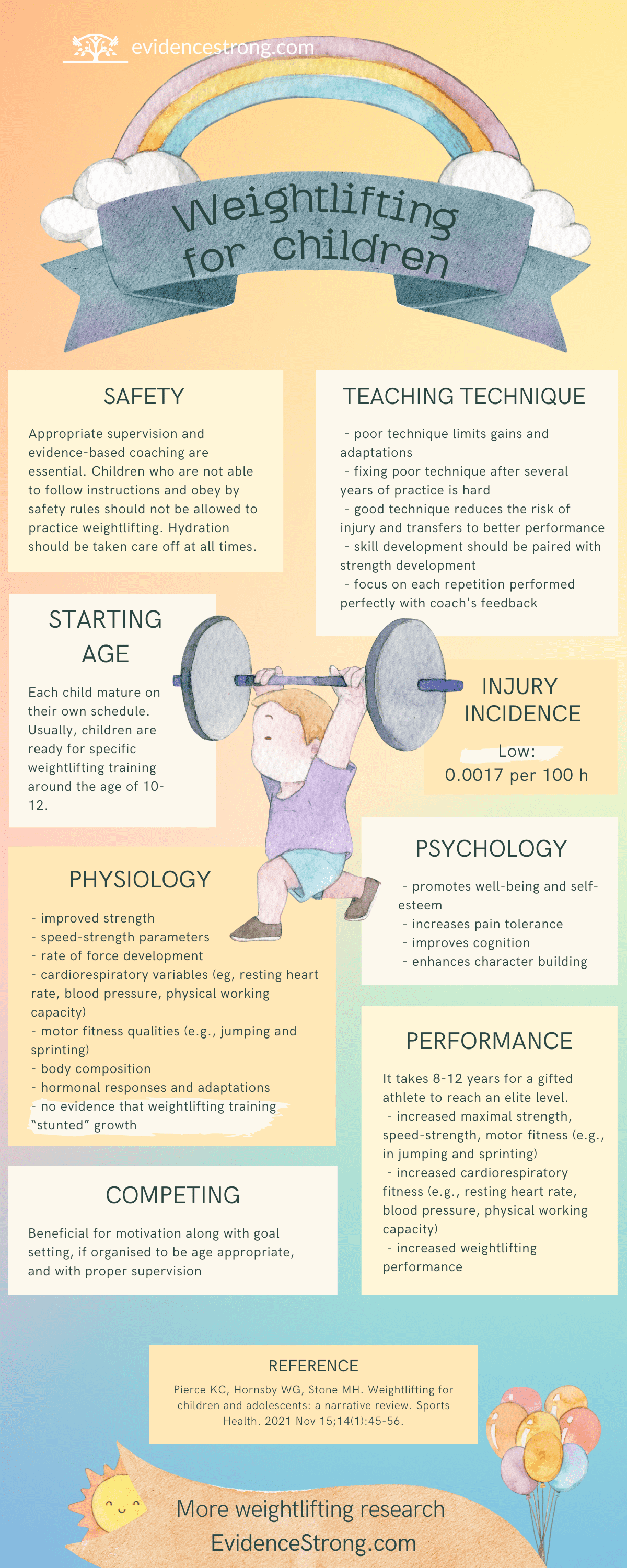Summary of a review article summarising literature on the influence of Olympic weightlifting training on children.
Who
Weightlifting youth athletes
Design
Narrative review of the literature.
Outcome measures/tests
- safety
- starting age
- development
- teaching technique
- injury incidence
- psychological changes
- physiological changes
- performance changes
- competing
Main results
safety: appropriate supervision and evidence-based coaching are essential. Children who are not able to follow instruction and obey by safety rules should not be allowed to practice weightlifting. Hydration should be taken care off.
starting age: each child mature on their own schedule, so the same chronological age (years) does not equal the same maturation level (Tanner stage). Usually, children are ready for specific weightlifting training around the age of 10-12. You can find data on the age of starting for Tokyo 2020 weightlifing medalists here. Early training (before the age of 12) should focus on developing fundamental movement and athletic skills (walking, running, jumping, catching, hopping and galloping), and general physical preparation (strength, flexibility).
development:
there seem to be two periods with rapid maturation of the brain, between the ages of 6 and 8, and 10 and 12. Possible acceleration of neuromuscular system has been proposed. These age groups may especially benefit from weightlifting training.
When starting, specific weightlifting training should not exceed 40% of total trainig . The first year should include a variety of exercises: basic gymnastics, track and field, basketball, volleyball movements (with 8-12 repetitions per set; 2-3 days per week; weightlifting lifts performed for 3 or less repetition with emphasis on perfect technique of each rep).
Secong year should still focus on general physical development (50%) and correct technique while learning weightliting lifts.
In the third year weightlifting training could increase to 55-60%, and up to 70% in the 4th year.
activities like long-distance running, swimming and cycling should be possibly limitted as they may negatively influence explosiveness (but research on this was mainly done on adolescents and adults, so be catious with applying to children).
technique should be always emphasised and weights should be minimal. The use of wooden sticks when practicing technique to reduce load is recommended, with possible progress to age- and size-appropriate training bars.
consider letting children participate in planning (for example choosing some exercises)
coach to athlete ratio of 1:10 or less is advised up to junior high level, and 1:15 from high school level
teaching technique:
- the way kids perform the movement (technique) will last for years, so it is important to instil correct patterns.
- fixing poor technique after several years of practice is hard
- poor technique limits gains and adaptation
- good technique reduces the risk of injury
- good technique transfers to better performance
- skill development should be paired with strength development
- focus on each repetition performed perfectly with coach’s feedback is advised
injury incidence in children and adolescent who do weightlifing is low: 0.0017 per 100 hours of training. Injuries are usually related to preventable accidents and/or fatigue (creating adipokine alterations, increased cortisol and decreased testosterone, increased inflammation, possibly immunosuppression). They can also happen due to poor technique, lack of concentration and lack of adherence to safety procedures with using equipment/facility.
competition:
- in age-appropriate, supervised and athlete has a sound technique it can enhance motivation and keep youth athlete in sport
Risks:
- if not supervised properly, weightlifting enviroment may be prone to accidents. However, research shows that under proper supervision weightlifting has no more (or even less) injury rates than other sports.
- fatigue (acute or accumulative) can predispose youth athletes to injuries and should be monitored and managed
- no evidence that weightlifting stunts growth
Performance: it takes 8-12 years for a gifted athlete to reach an elite level. Performance improvements depend on the training age.
- increased maximal strength, speed-strength, motor fitness (e.g., in jumping and sprinting)
- increased cardiorespiratory fitness (e.g., resting heart rate, blood pressure, physical working capacity)
- improved body composition and general well-being
- increased weightlifting performance
Psychological effects:
- promotes well-being, self-esteem
- increases pain tolerance
- improves cognition
- enhances character building (caoches can link how weightlifting training is similar to difficult parts in life which can be overcome with diligence)
differences between girls and boys:
- anabolic and catabolic hormones levels’ are different
- menstrual cycle in adolescent girls may influence weightlifting training, as well as contraceptives (you can read more about it here)
- upper body muscle mass and strength differ with boys becoming stronger and more muscular from the adolescence.
- explosive strength, power outputs are typically lower in females (65-70% of men’s). Also, female athletes present with electromechanical delay
Take home message
Interview with the author of the original article
Guy Hornsby is an assistant professor at the Department of Kinesiology and Health Science, Louisiana State University Shreveport and Performance Science Head Coach of West Virginia Weightlifting.
Original article
Pierce KC, Hornsby WG, Stone MH. Weightlifting for children and adolescents: a narrative review. Sports Health. 2021 Nov 15;14(1):45-56.
You might want to read next
How early can you specialize in weightlifting and still be safe in terms of injuries
Is weightlifting safe for young athlete’s back?
What happens during 10 years of Olympic weightlifting? (in women)
Steroid hormones’ levels and Olympic weightlifting performance

